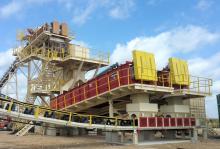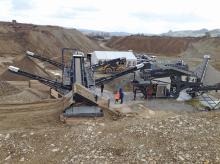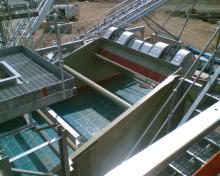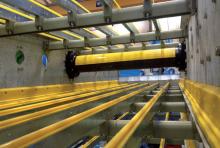
Aggregate washing is helping quarries in Europe to improve the quality of end products and add value. Claire Symes looks at the technological developments
Stricter aggregates specifications and the need to make the best use of all extracted material is driving greater use of washing equipment. But the latest technology means that this growth does not have to significantly impact on energy or water consumption.
"Washing is also enabling quarries to meet demand for sand. Many sand reserves are running out but modern washing techniques means that dust can be treated to replace sand content," said Greystone vice president John Bennington. "Also as quarries progress, the more easily extracted material is less available and quarries are having to process material with a higher level of clay and silt."
Finedoor commercial director Jim Blanchard has also witnessed the growth of the washing industry. "There is also greater need to wash hard rock material where previously it would have been considered waste," he said. "Now there is a general move to make better use of 6mm product that would have had a very low value before or been disposed of as waste.
"One customer in Aberdeen, Scotland had a large stockpile of dumped material that they needed to treat or would be charged to dispose of as waste. The site also used to import fine material for its coating plant but is now washing its waste material instead. More quarries are looking to specialise and make the best from both primary and secondary aggregates."
However, the decision on what equipment a quarry needs has to be considered in the context of both the feed material and the final product, as well as understanding the normal production volumes and realistic future targets. "There is no one size fits all when it comes to washing and quarries need to be careful they have the right advice and not just buy on price," explained Blanchard. "One thing that does help is that if borehole information is available, then the design can be based on future reserves rather than just on current production."
"What has changed over the last five to 10 years is the growth in water treatment," said Blanchard. "Dewatering screens have also become more popular as quarries have recognised that a drier product is more profitable and it also allows more water to be recycled."
Bennington added, "There is a big trend towards consideration of the environmental impact of quarrying and that includes reducing run off, which has driven wider use of dewatering screens and water reclamation techniques. But there is also a focus on more energy efficient techniques, so some quarries now use a standard dewatering screw to discharge onto a dewatering screen to reduce the moisture content to 10% but returns any material that falls through the screen back onto the screw to remove the need for a cyclone. This uses 30 to 50% less energy."
Another development is the mobile washing unit, according to
"The development of mobile washing equipment has also been useful for quarries that are new to washing and unsure about the benefits for their products but most are convinced once they have trialled systems. Many quarries have been happy in the past to supply out of spec 0-4mm sand at a low price but with washing they can meet the specification and double the value of the material."
Brooksby benefits
Lafarge's Brooksby quarry is one of the latest sand and gravel pits to benefit from aggregate washing capabilities. The site in Leicestershire, UK is the proud owner of a new 180tonne per hour sand and gravel washing plant specifically designed by Northern Ireland-based CDE.
The quarry opened in 2007 with a licence to extract 300,000tonnes per year giving it 15 year's worth of reserves but within months Lafarge was looking for a way to improve production. "The presence of clay in the raw feed was proving to be a problem with our previous processing system and this was having a significant impact on the quality and commercial value of our final products," said Lafarge national production manager Andy Morris.
According to Morris, Lafarge selected CDE to develop a bespoke solution for Brooksby after previous unsuccessful use of off-the-shelf systems. CDE carried out detailed laboratory analysis of the feed material and designed a plant with this and the end product - three aggregate and two sand grades - in mind.
The final plant configuration at Brooksby includes CDE's hoppers, conveyors, ProGrade screens (both rinsing and dry sizing screens are included), the new AggMax attrition and classification system and an A-series EvoWash sand plant.
The feed material is loaded into the feed hopper which feeds a horizontal ground conveyor. From here the material is then transferred to a 28m static feed conveyor on its way to the primary screening phase. Due to the levels of clay in the feed material the conveyor is fitted with Hosch scrapers to ensure the belts stay as clean as possible, minimising spillage and ultimately increasing plant efficiency.
At the primary screening stage a ProGrade R211 double deck rinsing screen is employed and is set up with two polyurethane decks. The oversize (+40mm) material is discharged into a concrete bay beneath the screen while the <5mm material and waste water are sent to the EvoWash sand plant.
The 5mm to 40mm material is delivered directly to the AggMax system, which combines the RotoMax attrition system and ProGrade dewatering screens in a compact configuration. The RotoMax system has been introduced to specifically tackle the level of clay in the feed material The waste water from the RotoMax is sent to the EvoWash sand plant to recover any of the <5mm material that made it past the first screening stage. Meanwhile, the scrubbed >5mm material is delivered from the RotoMax onto a ProGrade C-series dewatering screen before being sent to the dry sizing screen via a 20m static transfer conveyor. The dry sizing screen on this plant is a ProGrade D26 double deck screen measuring 4m x 1.5m with two polyurethane decks. The dry sizing screen classifies the products into 5-10mm, 10-20mm and +20mm aggregates which are transferred to stockpiles by three 20m static conveyors.
Lafarge reports that the plant is working well and living up to expectations.










